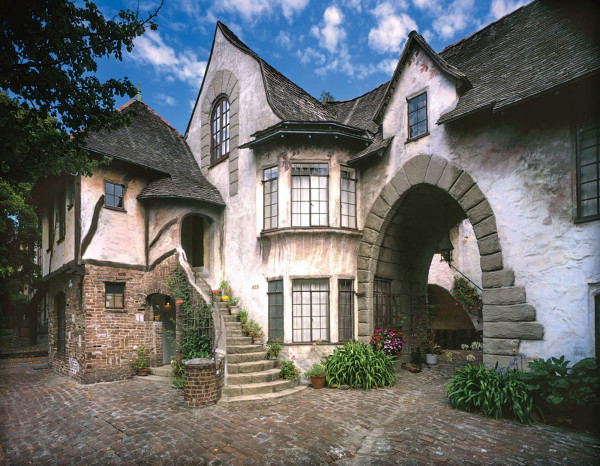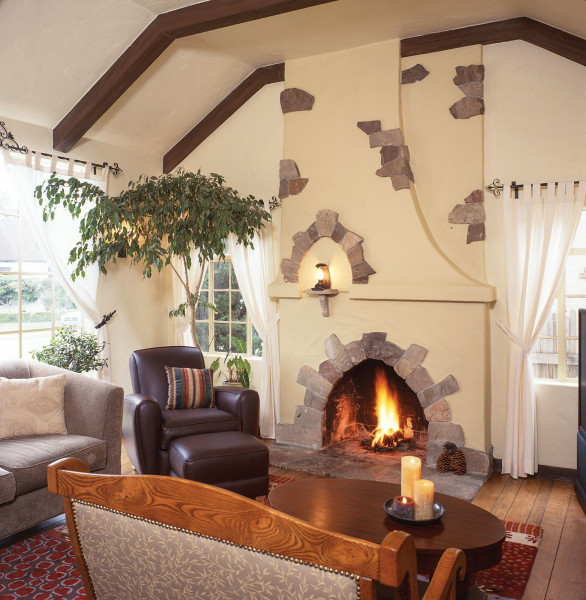
Spadena House in Beverly Hills, “ a cleverly wrought caricature of dilapidated antiquity,” is the ultimate Storybook example.
Douglas Keister
Fairytale, Hansel & Gretel, Storybook: These are names commonly given to a whimsical style that enjoyed only a brief moment but never ceases to bring a smile. It appeared in the Los Angeles area in the early 1920s, reached its height of popularity just before the Depression, and then it was gone, save for a few isolated examples. The style is theatrical and often humorous. The houses are unusually well crafted, of brick and stucco, shingles and even thatch—all artistically rendered to suggest great age.
Storybook Hallmarks
• FANTASY What distinguishes a Storybook from a Revival house is exaggeration. Look for a turretr and rubble stone or clinker brick and a catslide roof, plus such nonfunctional whimsy as fake dovecotes and castle-like crenellations.
• EUROPEAN DETAILS Look for Spanish ironwork, French Norman towers, Tudor half-timbering, round-arch doors, rolled-eave “thatched” roofs and jerkin-head gables, medieval stained glass, and casement windows.
• FALSE AGING The roof ridge may be swaybacked, the rough-troweled stucco “peeling” to reveal rubble stone, the shingles laid in irregular waves. Sometimes walls purposely were built out-of-square and out-of-plumb.
• MANIPULATION Many of these houses have wings and gables and add-ons that both suggest they grew over the ages and that hide their true size. Steep roofs, oversize and undersize elements manipulate scale.

Normandy Village, an apartment complex in Berkeley built 1926–28 by William R. Yelland, was to be an evocation of rural villages in Northern France, patterned on war memories.
Douglas Keister
Did you know that the famous sign, when constructed, read HOLLYWOODLAND? That’s right—it was the promotional sign for a subdivision begun in 1923. The developers required that homes be built in “French Normandy, Tudor English, Mediterranean and Spanish styles,” a nod to the growing popularity of Historical Revival styles. The architecture police weren’t patrolling however, and some of the homes constructed were, well, eccentric. A crack publicity staff succeeded in attracting the likes of Bela Lugosi, Humphrey Bogart, Gloria Swanson, and cellist Efrem Zimbalist Sr. Some early, and well publicized, revival houses were built in Hollywoodland, which crossed a line into what can only be called Storybook Style.
It’s no surprise that the center of the theatrical Storybook Style should be the land of make-believe. Stars wanted flamboyant, one-of-a-kind homes. Los Angeles was full of set designers and craftsmen used to evoking foreign locales and a sense of the past for the movies. “Most of the homes were relatively sober examples of Spanish Revival, Normandy, or half-timbered styles,” writes Arrol Gellner in the book Storybook Style, “ yet tucked among them were found isolated outbreaks of Storybook madness. Los Angeles, a city renowned for its youth and impermanence, would devise for America the consummate version of instant antiquity.”
Spadena House, for example, was designed by the art director Harry Oliver in 1921 and built for the Willets studio in Culver City to house offices and dressing rooms. It doubled as a movie set and appeared in silent films. (In 1934 it was relocated to Beverly Hills, and has since been a private residence.)

Inside a house by W.W. Dixon.
Douglas Keister
The style is easy to spot: battered walls, upswept roofs, deeply recessed front doors in archways with a random edging of bricks or stone and perhaps brick voussoirs, turrets and entry towers, exaggerated or cartoonish chimneys, metal casement windows, jerkin-head dormers, rough-troweled stucco. The roofs are often a giveaway: usually laid with wood shingles or slate, they may even have a sway or sag in the ridge, suggesting great age.
The style did not, of course, spring from nowhere overnight. It was, perhaps, a manifestation of the Picturesque movement that started in 18th-century England—architecture based on vernacular, medieval forms, meant to elicit emotion more than intellectual appreciation. By the 1920s the popularity of Spanish Revival architecture, especially in California, had broadened into a fascination with European revival styles in general. Storybook Style is the most exuberant. It spread across the country, courtesy of movie celebrity and magazines. Though not common, Storybook houses can be found from Milwaukee to Maryland, in Washington, D.C., and Asheville, N.C., and even in staid New England.
See also: Storybook Style
Looking for resources? See Sources for Storybook Houses







